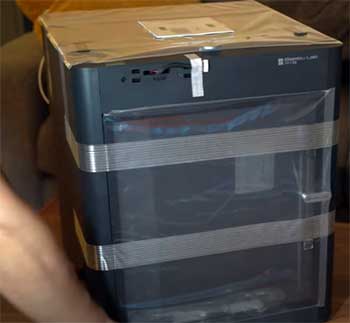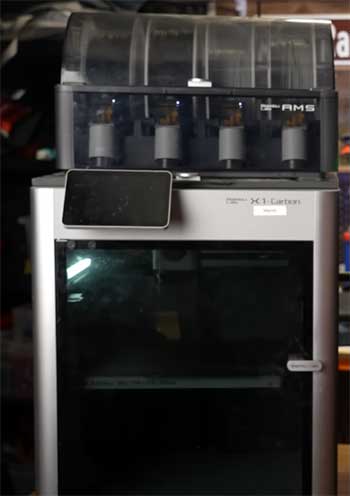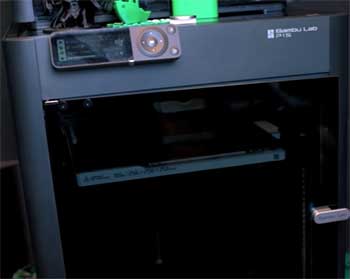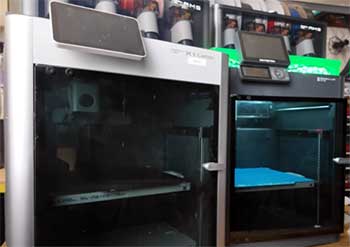I’ve been hooked on 3D printing for years, turning digital designs into tangible creations that range from quirky game pieces to functional drone parts. When it came to upgrading my setup, I found myself torn between the Bambu Lab P1S and the X1 Carbon.
Both are stellar machines from a brand that’s shaking up the 3D printing world, but they cater to slightly different needs.
In this article, I’ll share my hands-on experience, breaking down their features, pros, cons, and which one might suit you best, all while keeping it real and relatable.
A Quick Comparison Table
| Feature | Bambu Lab P1S | Bambu Lab X1 Carbon |
| Price | ~$699 (or $949 with AMS) | ~$1,450 (includes AMS) |
| Build Volume | 256 x 256 x 256 mm | 256 x 256 x 256 mm |
| Enclosure | Plastic, fully enclosed | Aluminum frame, glass top/doors |
| Max Print Speed | 500 mm/s | 500 mm/s |
| Max Acceleration | 20,000 mm/s² | 20,000 mm/s² |
| Hotend | Stainless steel (upgradable) | Hardened steel (abrasive-ready) |
| Bed Temperature | Up to 100°C | Up to 110°C |
| Display | 2.7-inch LCD, D-pad interface | 5-inch color touchscreen |
| Sensors | Auto bed leveling, basic sensors | LiDAR, filament run-out, spaghetti detection |
| Camera | 720p, 0.5 fps | 1080p, higher frame rate |
| Material Compatibility | PLA, PETG, TPU, ABS (upgradable for carbon fiber) | PLA, PETG, TPU, ABS, carbon fiber, nylon |
| Connectivity | Wi-Fi, USB | Wi-Fi, Ethernet, USB |
| AMS Compatibility | Yes (optional) | Yes (included) |
| Best For | Hobbyists, educators, beginners | Professionals, advanced users |
My Journey With Bambu Lab Printers
I got my first 3D printer—a creaky DIY kit—five years ago, and it sparked a passion for creating everything from cosplay props to custom tools. Fast-forward to today, and I’m knee-deep in the Bambu Lab ecosystem, having tested both the P1S and X1 Carbon extensively.
These machines are game-changers, blending speed, quality, and user-friendly features that make 3D printing feel less like a chore and more like magic. But choosing between them wasn’t straightforward, so let me walk you through what I’ve learned from months of printing, tweaking, and tinkering.
- Build Quality and Design

The first thing I noticed unboxing the P1S was its sleek, transparent plastic enclosure.
It’s like a window into the printing process, letting me watch layers stack up in real-time.
The enclosure is sturdy enough for home use, but I did wonder about its long-term durability under heavy workloads.
Plastic can scratch or crack over time, especially if you’re moving the printer around or printing non-stop.
Still, it does a fantastic job of keeping temperatures stable, which is crucial for materials like ABS that hate drafts.
Then there’s the X1 Carbon, which feels like the premium cousin. Its aluminum frame and glass doors scream durability and sophistication. I set it up in my workshop, and it’s held up beautifully, even with near-daily use.
The metal construction not only looks sleek but also adds stability, reducing vibrations during high-speed prints. The activated carbon filter is a nice touch, too, especially when printing smelly materials like ABS. If you’re in a shared space or sensitive to odors, the X1 Carbon’s enclosure is a step above.
Both printers share the same 256 x 256 x 256 mm build volume, which is plenty for most projects. I’ve printed everything from large drone frames to intricate tabletop miniatures without issue.
However, the X1 Carbon’s robust build gives it an edge for professional setups where longevity and aesthetics matter.
- Speed and Performance

Speed is where both the P1S and X1 Carbon shine, thanks to their CoreXY motion systems.
Both boast a max print speed of 500 mm/s and acceleration up to 20,000 mm/s², making them some of the fastest consumer printers out there.
I tested this by printing a Benchy (the 3D printing torture test) on both.
The P1S clocked in at about 1 hour 20 minutes on “ludicrous” mode, and the X1 Carbon was nearly identical. The catch?
Real-world speeds depend on your model’s geometry and settings.
Complex prints with lots of retractions slow things down, but both machines handle it with grace.
The X1 Carbon pulls slightly ahead with its advanced firmware and precise stepper motors. I noticed crisper edges and smoother surfaces on intricate prints, like a multi-part mechanical toy.
The P1S isn’t far behind, but I occasionally spotted minor layer adhesion issues with trickier materials like PETG. For most hobbyist projects, though, the difference is subtle.
One area where the P1S surprised me was its quiet operation. It’s noticeably less noisy than the X1 Carbon, which makes it ideal for home offices or small apartments. I ran a 12-hour print on the P1S while working nearby, and it didn’t drive me up the wall.
The X1 Carbon, while not loud, has a bit more hum, especially at high speeds.
- Material Compatibility
Material versatility is a big deal for me since I dabble in everything from PLA for quick prototypes to carbon fiber for durable parts. The X1 Carbon is ready out of the box for abrasive materials like carbon fiber and nylon, thanks to its hardened steel nozzle and extruder gears.
I printed a carbon fiber-reinforced drone arm, and the results were tough as nails with no visible wear on the hotend.
The P1S, however, comes with a stainless steel nozzle, which is great for PLA, PETG, TPU, and standard ABS but needs an upgrade for abrasive filaments. I swapped in a hardened nozzle ($15 on Bambu’s store) and printed some carbon fiber PLA without issues, but it’s an extra step and cost.
The P1S’s bed tops out at 100°C, which is fine for most materials but can struggle with high-temperature filaments like polycarbonate. The X1 Carbon’s 110°C bed handles these with ease, giving it a clear edge for engineering-grade projects.
Both printers excel with Bambu’s Automatic Material System (AMS) for multi-color printing. I printed a vibrant Settlers of Catan set on the P1S with AMS, swapping between four colors seamlessly.
The X1 Carbon includes the AMS in its price, while it’s a $250 add-on for the P1S. If multi-color printing is your jam, factor that into your budget.
- User Interface and Software
Navigating the P1S’s 2.7-inch LCD and D-pad interface feels like using an old MP3 player. It gets the job done—starting prints, adjusting temps, loading filament—but it’s clunky. I found myself relying on Bambu Studio or the Handy app for most tasks. The app’s remote monitoring and control are a lifesaver, letting me check print progress from my phone while grabbing coffee.
The X1 Carbon’s 5-inch color touchscreen is a game-changer. It’s intuitive, showing a preview of your model before printing and making tasks like filament changes a breeze.
I rarely needed the app with the X1 Carbon because the onboard interface is so good. Both printers use Bambu Studio, a slick slicing software with cloud integration. The X1 Carbon’s AI-assisted slicing and advanced material profiles give it a slight edge for complex prints, but the P1S’s simpler interface is beginner-friendly.
- Sensors and Automation

Automation is where the X1 Carbon flexes its muscles.
Its LiDAR sensor and dual auto bed leveling ensure near-perfect first layers every time.
I printed a thin-walled vase, and the X1 Carbon nailed the first layer without any babysitting.
It also has a filament run-out sensor and spaghetti detection, which saved me from a few failed prints when filament tangled or ran out.
The P1S has auto bed leveling, which works well for most prints, but lacks the LiDAR and advanced sensors. I had to tweak flow rates manually for some PETG prints to avoid under-extrusion.
It’s not a dealbreaker, but the X1 Carbon’s extra sensors make it more forgiving, especially for advanced users tackling tricky materials.
- Print Quality
Print quality is where both printers earn their stripes. I printed a detailed Pumpkin Girl mask (a design by Pipe Cox) on the P1S with four colors, and the results were stunning—sharp details, vibrant colors, and no visible layer lines at 0.2 mm layer height.
The X1 Carbon took it up a notch with a carbon fiber-filled gear, delivering impeccable surface finish and dimensional accuracy. For high-precision projects, like functional prototypes, the X1 Carbon’s LiDAR and optimized firmware give it a slight edge, but the P1S holds its own for most hobbyist needs.
I ran consistent tests with 300 mm/s inner walls, 200 mm/s outer walls, and 10% gyroid infill. Both printers delivered reliable results, but the X1 Carbon’s prints had marginally better overhangs and bridging, especially on complex models like a 3D-printed articulated dragon.
- Maintenance and Upkeep
Maintaining a 3D printer can feel like caring for a finicky pet, but both the P1S and X1 Carbon are relatively low-maintenance. The P1S’s straightforward design makes nozzle cleaning and belt tensioning a breeze.
I had to clean the nozzle after a few ABS prints to prevent clogs, but Bambu’s documentation guided me through it.
The X1 Carbon requires a bit more attention due to its advanced features. Calibrating the LiDAR and checking the filament run-out sensor took some trial and error, but the included manual and online community were lifesavers.
Both printers benefit from Bambu’s robust support, with detailed guides and an active user base on forums like Reddit.
- Price and Value
Price is where the decision gets tricky. The P1S retails at around $699 (or $949 with AMS), making it a fantastic value for hobbyists and educators. I got mine during a Black Friday sale for $859 with the AMS, and it felt like a steal for the performance.
The X1 Carbon, at $1,450 (AMS included), is a bigger investment. For me, the premium build, touchscreen, and advanced sensors justified the cost, especially for my robotics projects requiring exotic materials.
If you’re a beginner or printing mostly PLA and PETG, the P1S delivers 90% of the X1 Carbon’s performance at half the price. But if you’re a pro needing top-tier precision and material versatility, the X1 Carbon’s extras are worth it.
Pros And Cons of Bambu Lab P1S And X1 Carbon
Bambu Lab P1S
Pros:
- Affordable at $699, or $949 with AMS.
- Fully enclosed for temperature-sensitive materials like ABS.
- Fast print speeds (up to 500 mm/s) with solid quality.
- Quiet operation, ideal for home use.
- User-friendly software with Wi-Fi and app integration.
- AMS compatibility for multi-color printing.
Cons:
- Plastic enclosure may lack long-term durability.
- No LiDAR or filament run-out sensor.
- Basic LCD interface feels dated.
- Needs upgrades for abrasive materials like carbon fiber.
- Limited bed temperature (100°C).
Bambu Lab X1 Carbon
Pros:
- Premium aluminum and glass build for durability.
- Hardened steel nozzle for abrasive materials.
- 5-inch touchscreen is intuitive and user-friendly.
- Advanced sensors (LiDAR, filament run-out, spaghetti detection).
- Higher bed temperature (110°C) for technical filaments.
- Includes AMS for multi-color printing.
Cons:
- Expensive at $1,450.
- Slightly noisier than the P1S.
- More maintenance due to advanced features.
- Overkill for beginners or simple PLA projects.
Who Should Buy Which Printer?

The P1S is my go-to recommendation for hobbyists, educators, or anyone new to 3D printing. Its affordability, ease of use, and ability to handle common filaments make it a no-brainer. I’ve used it for everything from multi-color game pieces to ABS prototypes, and it rarely lets me down.
If you’re on a budget or don’t need exotic materials, the P1S is your ticket to high-quality printing without breaking the bank.
The X1 Carbon, on the other hand, is built for pros and advanced hobbyists. Its premium features—like the LiDAR sensor, touchscreen, and abrasive-ready hotend—make it ideal for engineering-grade projects.
I’ve relied on it for carbon fiber parts and high-precision prototypes, and it’s worth every penny if your work demands top-tier performance.
Real-World Use Cases
Let’s talk real-world scenarios. For a hobbyist like me, the P1S was perfect for printing a multi-color Settlers of Catan set for game night. The AMS made color swaps effortless, and the enclosed chamber ensured clean prints.
For a robotics project, I turned to the X1 Carbon to print carbon fiber-reinforced parts. The hardened nozzle and precise bed leveling delivered parts that fit perfectly, saving me hours of post-processing.
Educators might love the P1S for its affordability and ease of use in classrooms. Professionals in R&D or small-scale production will appreciate the X1 Carbon’s reliability and material versatility. Your choice depends on your projects and budget.
Frequently Asked Questions (FAQ)
The X1 Carbon has a LiDAR sensor for precise bed leveling, a filament run-out sensor, spaghetti detection, a 5-inch touchscreen, and a hardened steel nozzle for abrasive materials like carbon fiber. It also supports higher bed temperatures (110°C vs. 100°C) and Ethernet connectivity.
Yes, but it requires a hardened steel nozzle upgrade ($15) since the stock stainless steel nozzle isn’t suitable for abrasive filaments like carbon fiber.
For professionals or advanced users needing high precision and exotic material support, the X1 Carbon’s premium features justify the $1,450 price. For hobbyists or beginners, the P1S offers similar performance at a lower cost.
Conclusion: Which One’s Right For You?
After months of printing with both the P1S and X1 Carbon, I can say they’re both phenomenal, but your choice hinges on your needs. If you’re a hobbyist, educator, or just starting out, the P1S gives you speed, quality, and affordability in a user-friendly package.
If you’re a pro tackling complex projects or abrasive materials, the X1 Carbon’s advanced features and premium build are worth the splurge. Think about your budget, materials, and goals—you’ll find the perfect fit to bring your creations to life.
